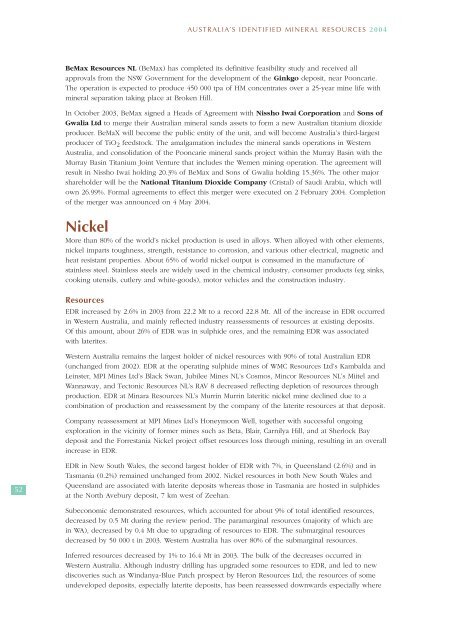australia's identified mineral resources 2004 - Geoscience Australia
australia's identified mineral resources 2004 - Geoscience Australia
australia's identified mineral resources 2004 - Geoscience Australia
You also want an ePaper? Increase the reach of your titles
YUMPU automatically turns print PDFs into web optimized ePapers that Google loves.
AUSTRALIA’S IDENTIFIED MINERAL RESOURCES <strong>2004</strong><br />
BeMax Resources NL (BeMax) has completed its definitive feasibility study and received all<br />
approvals from the NSW Government for the development of the Ginkgo deposit, near Pooncarie.<br />
The operation is expected to produce 450 000 tpa of HM concentrates over a 25-year mine life with<br />
<strong>mineral</strong> separation taking place at Broken Hill.<br />
In October 2003, BeMax signed a Heads of Agreement with Nissho Iwai Corporation and Sons of<br />
Gwalia Ltd to merge their <strong>Australia</strong>n <strong>mineral</strong> sands assets to form a new <strong>Australia</strong>n titanium dioxide<br />
producer. BeMaX will become the public entity of the unit, and will become <strong>Australia</strong>’s third-largest<br />
producer of TiO 2 feedstock. The amalgamation includes the <strong>mineral</strong> sands operations in Western<br />
<strong>Australia</strong>, and consolidation of the Pooncarie <strong>mineral</strong> sands project within the Murray Basin with the<br />
Murray Basin Titanium Joint Venture that includes the Wemen mining operation. The agreement will<br />
result in Nissho Iwai holding 20.3% of BeMax and Sons of Gwalia holding 15.36%. The other major<br />
shareholder will be the National Titanium Dioxide Company (Cristal) of Saudi Arabia, which will<br />
own 26.99%. Formal agreements to effect this merger were executed on 2 February <strong>2004</strong>. Completion<br />
of the merger was announced on 4 May <strong>2004</strong>.<br />
Nickel<br />
More than 80% of the world’s nickel production is used in alloys. When alloyed with other elements,<br />
nickel imparts toughness, strength, resistance to corrosion, and various other electrical, magnetic and<br />
heat resistant properties. About 65% of world nickel output is consumed in the manufacture of<br />
stainless steel. Stainless steels are widely used in the chemical industry, consumer products (eg sinks,<br />
cooking utensils, cutlery and white-goods), motor vehicles and the construction industry.<br />
Resources<br />
EDR increased by 2.6% in 2003 from 22.2 Mt to a record 22.8 Mt. All of the increase in EDR occurred<br />
in Western <strong>Australia</strong>, and mainly reflected industry reassessments of <strong>resources</strong> at existing deposits.<br />
Of this amount, about 26% of EDR was in sulphide ores, and the remaining EDR was associated<br />
with laterites.<br />
Western <strong>Australia</strong> remains the largest holder of nickel <strong>resources</strong> with 90% of total <strong>Australia</strong>n EDR<br />
(unchanged from 2002). EDR at the operating sulphide mines of WMC Resources Ltd’s Kambalda and<br />
Leinster, MPI Mines Ltd’s Black Swan, Jubilee Mines NL’s Cosmos, Mincor Resources NL’s Miitel and<br />
Wannaway, and Tectonic Resources NL’s RAV 8 decreased reflecting depletion of <strong>resources</strong> through<br />
production. EDR at Minara Resources NL’s Murrin Murrin lateritic nickel mine declined due to a<br />
combination of production and reassessment by the company of the laterite <strong>resources</strong> at that deposit.<br />
Company reassessment at MPI Mines Ltd’s Honeymoon Well, together with successful ongoing<br />
exploration in the vicinity of former mines such as Beta, Blair, Carnilya Hill, and at Sherlock Bay<br />
deposit and the Forrestania Nickel project offset <strong>resources</strong> loss through mining, resulting in an overall<br />
increase in EDR.<br />
52<br />
EDR in New South Wales, the second largest holder of EDR with 7%, in Queensland (2.6%) and in<br />
Tasmania (0.2%) remained unchanged from 2002. Nickel <strong>resources</strong> in both New South Wales and<br />
Queensland are associated with laterite deposits whereas those in Tasmania are hosted in sulphides<br />
at the North Avebury deposit, 7 km west of Zeehan.<br />
Subeconomic demonstrated <strong>resources</strong>, which accounted for about 9% of total <strong>identified</strong> <strong>resources</strong>,<br />
decreased by 0.5 Mt during the review period. The paramarginal <strong>resources</strong> (majority of which are<br />
in WA), decreased by 0.4 Mt due to upgrading of <strong>resources</strong> to EDR. The submarginal <strong>resources</strong><br />
decreased by 50 000 t in 2003. Western <strong>Australia</strong> has over 80% of the submarginal <strong>resources</strong>.<br />
Inferred <strong>resources</strong> decreased by 1% to 16.4 Mt in 2003. The bulk of the decreases occurred in<br />
Western <strong>Australia</strong>. Although industry drilling has upgraded some <strong>resources</strong> to EDR, and led to new<br />
discoveries such as Windanya-Blue Patch prospect by Heron Resources Ltd, the <strong>resources</strong> of some<br />
undeveloped deposits, especially laterite deposits, has been reassessed downwards especially where

















